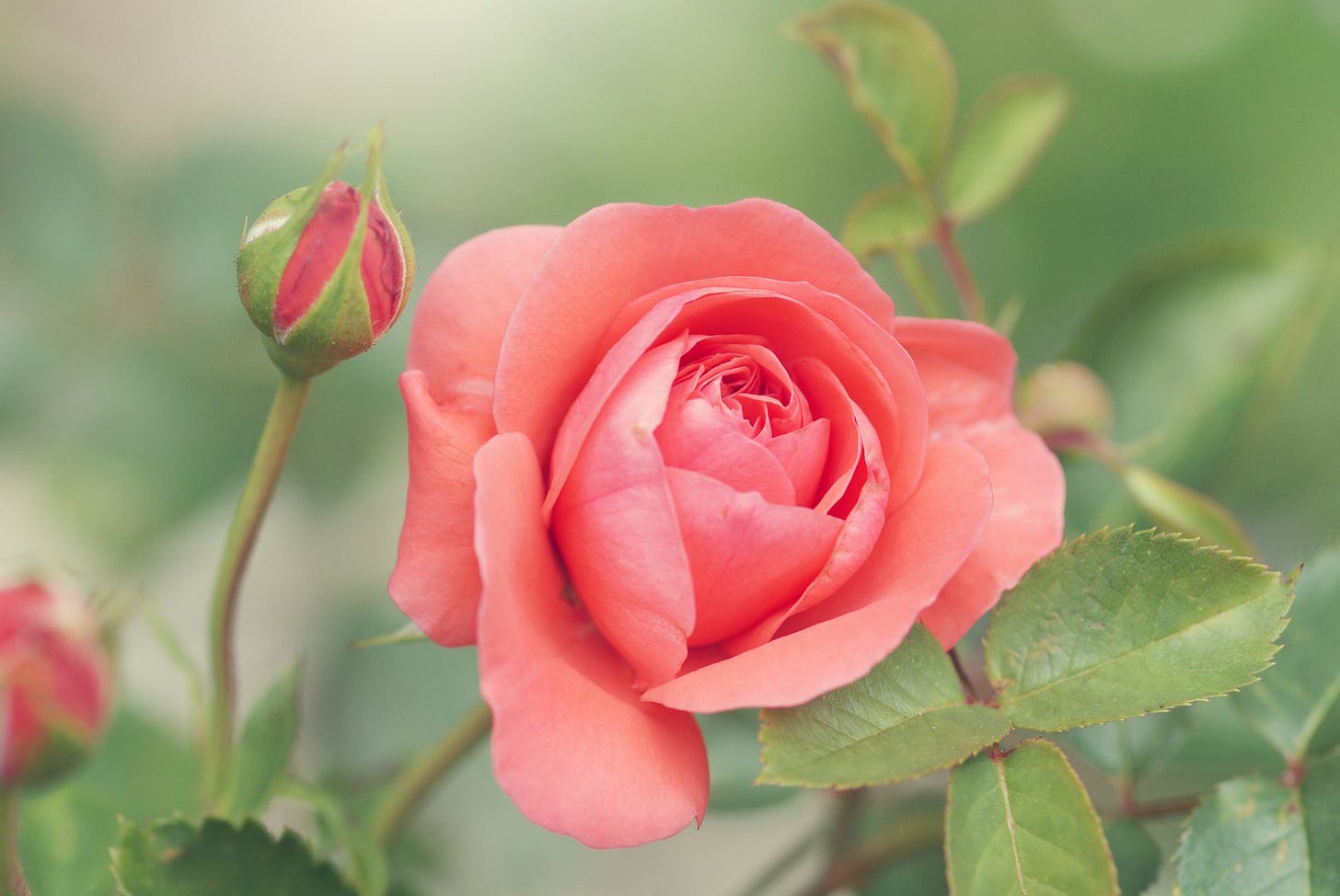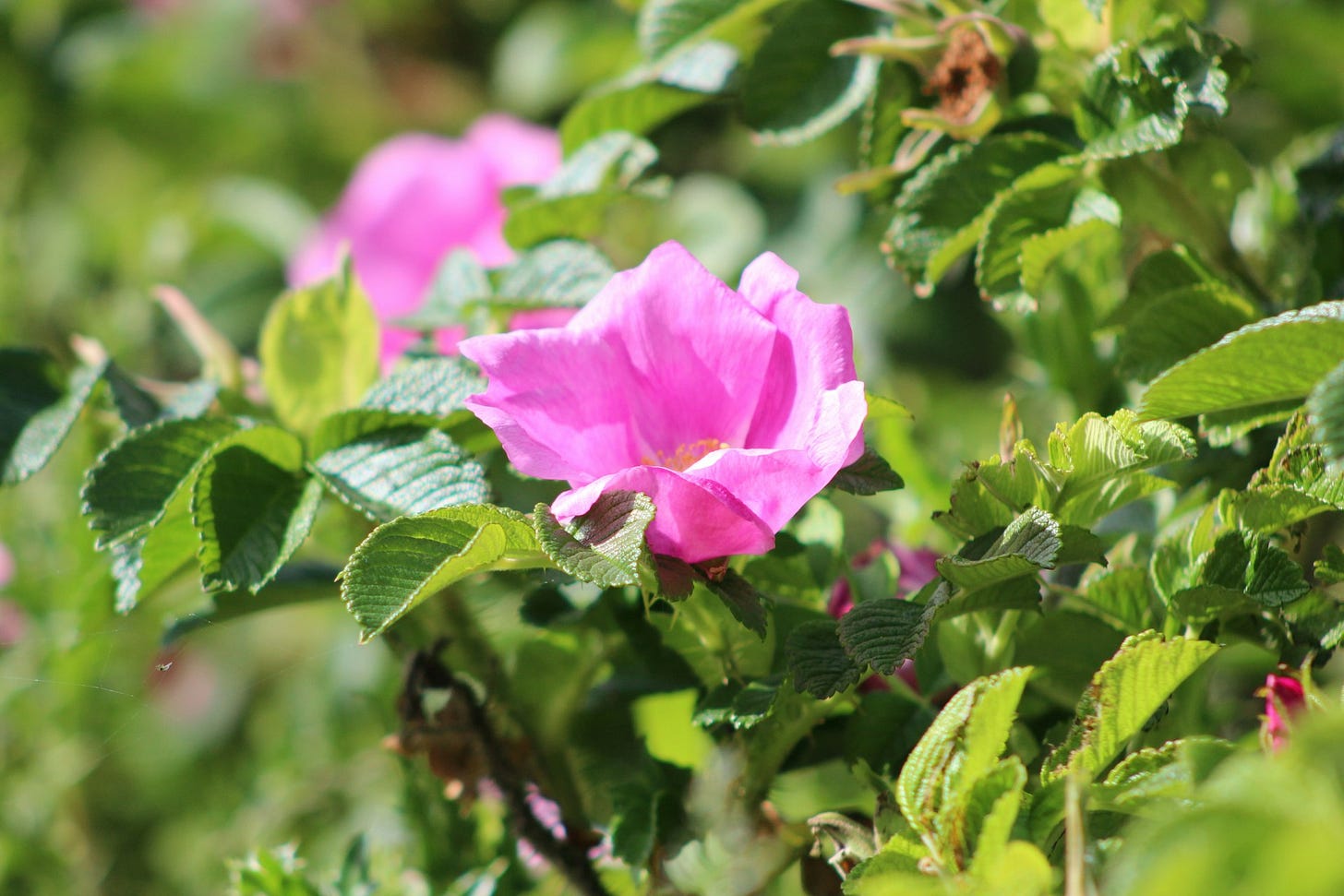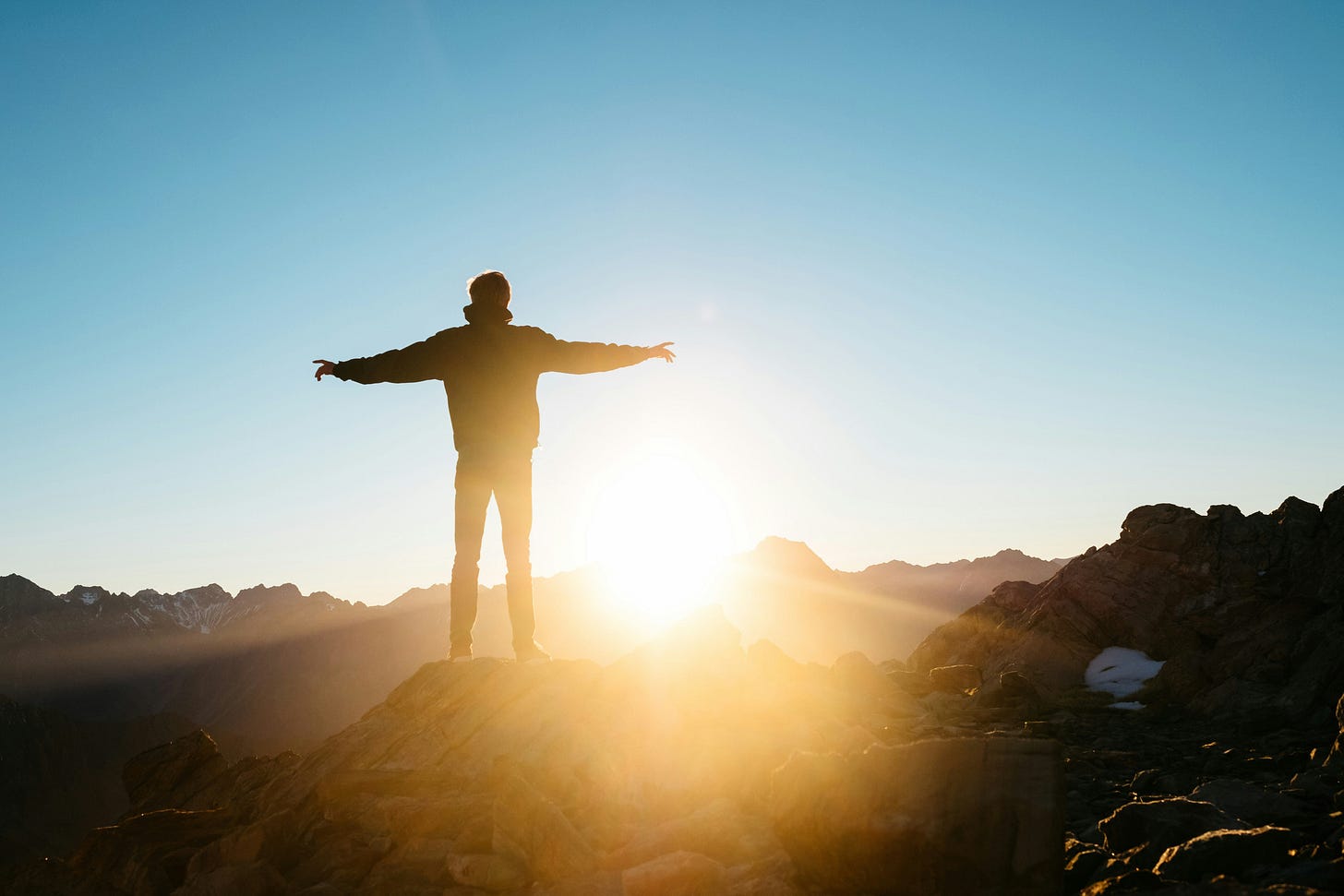What the World Needs Now is Love, Sweet Love
It's the only thing that there's just too little of.
First of All, the Rose, a Symbol of Love
“There is simply the rose; it is perfect every moment of its existence." – Ralph Waldo Emerson
While I was growing up, my grandparent’s house had a long fence in the front yard covered in roses. My grandfather, a gardener, tended them carefully. This involved spraying and sucking on a piece of candy while doing it to remind him not to breathe in the spray. (It’s funny, the things that stand out to little kids.)
Roses can be finicky. They are prone to diseases like Black Spot and pests like aphids. We must tenderly care for them (at least the more modern roses). But, in exchange, they tenderly care for us.
“There is simply the rose; it is perfect every moment of its existence." – Ralph Waldo Emerson
Roses have existed for 32 million years. And somewhere around 3,000 years ago, they were dubbed “the queen of flowers.” They’re prominent in literature, art, medicine, and, of course, things of love. They are also part of a botanical family (Roses) that includes many subfamilies (such as apples, plums, almonds, and rose itself). So, many of the plants we love—like raspberry, blackberry, strawberry, spirea, hawthorn, serviceberry, mountain-ash, apple, pear, quince, cherries, and plums—are related to the rose. This is a result of botanical re-classifications, which inspired these lines from Robert Frost:
“The rose is a rose, and was always a rose. But now the theory goes that the apple's a rose, and the pear is, and so's the plum, I suppose.”
Not all members of the rose family contain thorns, but many of them—the hawthorn tree and raspberry bushes, for example—contain thorns or prickles. I wrote a very sad piece of poetry in my early 20s after a breakup, bemoaning the thorns that lay hidden behind a rose flower. But I like this perspective better:
"Some people are always grumbling because roses have thorns; I am thankful that thorns have roses." - Alphonse Karr
My personal favorite rose is Rosa Rugosa. This is the species of rose that you see growing on the upper part of beaches and sand dunes (often dubbed “beach plum”). I like Rosa Rugosa’s simple 5-petaled flower, which is one of the botanical classifications of the rose family. The additional petals on multi-petaled roses are actually stamens that, through breeding, have come to resemble petals.
I also like that Rosa Rugosa is disease-resistant, easily self-propagated (through the roots), and very fragrant, and I could use it in my herbal practice. It has the largest rose hips, which are full of vitamin C. I never used the rose hips in my herbal teas, but I did use the dried petals. Besides their medicinal benefits, they add a lovely color and scent.
Roses are a nervine and can be used for depression/sadness, anxiety, and insomnia. This is typically done through aromatherapy, using rose essential oil. But the purest version of this oil is made from only two species (the most aromatic of roses—Rosa Damancena and Rosa centifolia), and it takes more than 60,000 freshly picked roses to create 1 ounce of essential oil, which makes unadulterated rose essential oil very pricey. As I write this, it is $238 (and up) on the site I buy herbs from! Rose water, also called rose hydrosol, is the byproduct of the steam distillation process of making the essential oil and is much, much cheaper and can be used externally for skin issues.
Internally, roses have been used to control coughs (they are anti-spasmodic), stem chronic diarrhea (they are an astringent), and stimulate digestion. Rose is also good for the skin—all skin types. Its anti-inflammatory properties can ease the symptoms of eczema, psoriasis, and other skin issues. Its astringent properties restrict blood vessels, which helps reduce the redness produced by broken capillaries. A cloth soaked in rosewater and laid across the temples can help reduce a headache.
Unfortunately, roses are not deer-resistant. My dogs kept deer out of our yard in Princeton, so I was spared the disappointment of roses chewed down to the ground. Buddy might help here if he pees around the area, but it won’t be the same as having a free-ranging (within an electric fence) dog. Still, I may give growing a rose bush a try. Varieties that are said to be more deer-resistant are Swamp rose (Rosa palustris), Virginia rose (R. virginiana), and Pasture rose (R. Carolina). All of these are shrub roses, like Rosa Rugosa.
So, now you know a little more about the beloved rose, a flower that practically has its own holiday! Happy (belated) Valentine’s Day.
Friends
I continue to attend a local Friends (Quaker) church, and I’ve found it to be a soft place to land with my faith. It feels expansive there—a place to set anchor and connect to community while my spirituality can continue to evolve. I think in-person human connection is essential in these chaotic times to keep us sane and focused on what really matters. We are building community in this place we live, as well. It’s hard to believe we’ve almost been here a year.
Love and Light
Service at the Friend’s church is silent, with people standing up to speak as they feel moved. Last week, a few people stood up, struggling with the chaos swirling around us in our country and the world, and reflecting upon that. Suddenly, a woman’s voice started singing “This Little Light of Mine,” and we all joined in the familiar verses.
This little light of mine,
I’m gonna let it shine.
This little light of mine,
I’m gonna let it shine.
This little light of mine,
I’m gonna let it shine.
Let it shine, let it shine, let it shine.
I got tears in my eyes and spirit chills in my body. It's such a simple yet powerful message. There is a lot of darkness out there. People are being hurt. The world we’ve known seems to be collapsing. What can we do? How can we help? Where can we shine our light? Who needs our love? When fearful thoughts assault us (and they do), take three deep, slow breaths and bring yourself back to thoughts of hope and love. It’s the energy the world needs, and it’s really the only place from which we should be making decisions. Clarity needs light, and things turn dark when our bodies enter the fight-or-flight territory of fear.
Back to the Rose
Perhaps it’s also time to add a little rose to your life—be that a plant, a bouquet you purchase from the store, rose hydrosol, or rose flower essence. (Or the essential oil if you feel like spending a lot of money.) You can also buy dried rose petals from Mountain Rose Herbs and make them into all sorts of lovely herbal products or just put them in a pretty bowl that you walk by often. Alternatively, you can close your eyes and imagine yourself in a beautiful garden full of roses, taking in their scent and beauty. Plants are healing. And the lovely rose/rose of love is precisely the healing we need right now.
“The sweetest flower that blows, I give you as we part. For you it is a Rose, for me it is my heart." – Frederick Peterson
From the Website…
Nothing from the website this month. I didn’t feel called to write much, which is probably EXACTLY what I should be doing. It’s also why this newsletter is going out at the very end of the month!
But in lieu of that, here is a link to the song I grew up with that is the title and subject of this newsletter. Dionne Warwick sang this performance in 1966 when I was just six. I’ve always believed in a world where people operated from a place of peace and love. And I’m holding onto that belief tightly.
Also, we need the folk songs from the 60s and 70s and their messages to come back into human consciousness.
Photo Credits:
Featured rose photo by Shannon Baldwin on Unsplash
Rosa Rugosa photo by Felix Schmidt on Unsplash
Man in the light photo by Pablo Heimplatz on Unsplash






